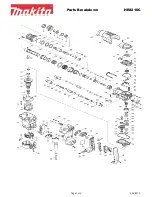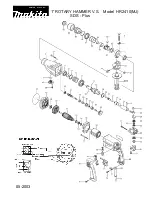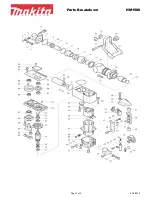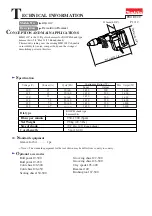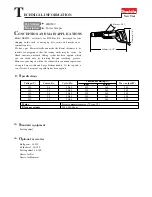
19
A table on the front of the drill head shows gear
change lever and motor switch values required
to select each speed. A similar table is included
in Section 10.0 of this manual.
On the gear change table you will also find the
recommended drill sizes for the various speeds
which are selectable.
These recommendations
are only approximate.
With the wide variety of
drill types and coatings available, as well as
cutting fluids, and the even wider variety of work
piece materials which you might be machining –
you need to consult with your tooling, coolant
and/or work piece suppliers to determine the
best spindle speed to use for any specific drilling
operation.
Do not try to change gears
while the spindle is turning.
This may cause
serious damage to the spindle drive system.
Allow the spindle to stop completely before
attempting to change gears. If the gear change
lever you want to move does not slip easily into
the new position, jog the motor for a second
using the control lever. Then allow the spindle to
come to a stop before attempting to change
gears again. Repeat this jogging process, as
necessary, until the gears match up properly for
changing.
Plan for quill movement
during high speed spindle rotation. High
speed rotation without quill travel will
increase spindle temperatures.
8.9
Feed rate and depth of cut
The J-1230R has limit switches on the quill
which cut power to the drive motor when the
quill has reached either the upper or lower limit
of its travel. This system is designed to prevent
gearbox damage if the power feed mechanism is
engaged – damage which would occur if the quill
were to bottom out against the upper or lower
limit of quill travel. In the event of failure of
either limit switch there is also a safety clutch
mechanism which will slip when travel limits are
reached.
However, while you are able to use virtually the
full travel of the quill for drilling or other
operations, the drill press operator typically sets
both the rate of feed (travel-per-revolution of the
spindle), and the depth of cut (quill travel to
make the required cut).
These two operations are described here:
8.10
Setting feed rate
The feed rate is set using the knob and dial on
the front of the drill head. See Figure 12. The
knob can be rotated to select any of three
different feed rates, plus a neutral position
where the power feed does not operate on the
quill.
Do not try to change feed
rate while the spindle is turning.
This may
cause serious damage to the spindle drive
system.
It is recommended that when doing operations
not requiring power feed that the dial be set to
neutral. This minimizes any wear on the power
feed mechanism.
Feed rate selection is indicated by a pair of rivet
heads (A, Figure 12) on opposing edges of the
dial. These values are indicated in smaller type
on the outer edge of the dial plate.
Figure 12
Any of the three feed rates are available for
selection using any of the spindle speeds
available. There will be a recommended feed
rate for any drilling or boring operation, and this
rate must be determined by consulting
appropriate machining handbooks or by
consulting with your tooling and work piece
suppliers.
Summary of Contents for J-1230R
Page 11: ...11 General Features and Terminology cont Figure 4 Figure 5 ...
Page 16: ...16 7 0 Operating Controls Figure 10 Operating Controls ...
Page 27: ...27 Figure 17 Figure 18 Figure 19 Figure 20 Figure 21 ...
Page 30: ...30 13 2 1 Column and Base Exploded View ...
Page 32: ...32 13 3 1 Arm Front Exploded View ...
Page 34: ...34 13 4 1 Arm Rear and Clamping Gearbox Exploded View ...
Page 38: ...38 13 6 1 Gearbox Assembly Head Exploded View ...
Page 42: ...42 13 7 1 Rear of Head I Exploded View ...
Page 45: ...45 14 0 Electrical Connections for J 1230R ...
Page 47: ...47 ...































